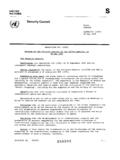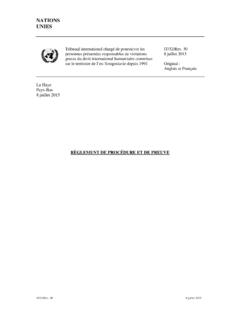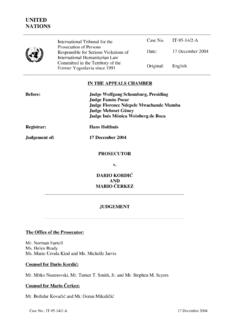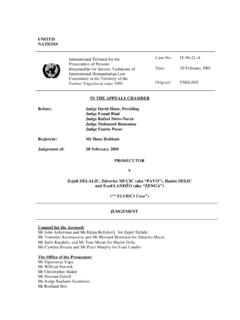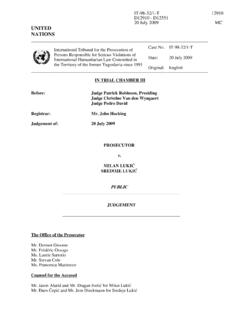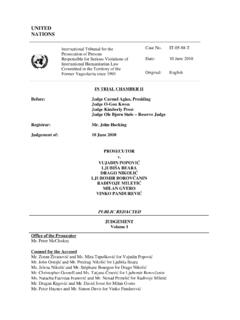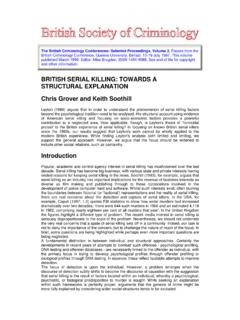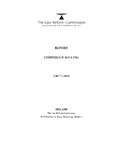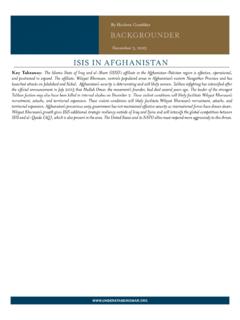Transcription of FACTS ABOUT SREBRENICA
1 1 FACTS ABOUT SREBRENICA In June 2005, during cross-examination of a witness in the case against Slobodan Milo evi 1 at the International Criminal Tribunal for the former Yugoslavia, the court viewed video footage showing a Serbian paramilitary unit, calling itself the Scorpions, execute six Bosnian Muslim men and teenagers captured after the fall of SREBRENICA in 1995. The images of Serbian soldiers tormenting and then shooting the Bosnian Muslim prisoners, whose hands were tied behind their backs and who offered no resistance before being shot, broke through the wall of silence and denial ABOUT the subject of SREBRENICA in Serbia and Montenegro. The Serbian Government condemned the killings, and the Serbian War Crimes Prosecutor acted swiftly to detain a number of suspects allegedly complicit in the murders of these six men.
2 There is a multitude of evidence publicly available that proves that Bosnian Serb and other forces executed 7,000 to 8,000 Bosnian Muslim prisoners from SREBRENICA in one week in July 1995. Despite this, there are still many people in Serbia and Montenegro who try to deny the full enormity of the crime that Bosnian Serb military, police and other forces (including, allegedly, forces from Serbia) committed. They argue that the actual number of dead is exaggerated, that only around 2,000 died. They also argue that most of these 2,000 dead were casualties of war Bosnian Muslim soldiers killed in battle. Some who are even bolder, claim that it was a 'crime of passion' revenge for all those Serbs killed in the villages around SREBRENICA .
3 Still others claim that what happened at SREBRENICA was not genocide. The Tribunal has proved beyond a reasonable doubt that each of these claims is wrong. The massacre that occurred in SREBRENICA in July 1995 was the single worst atrocity committed in the former Yugoslavia during the wars of the 1990s and the worst massacre that occurred in Europe since the months after World War II. This is why the ICTY, which was established in 1993 to try those most responsible for serious violations of international humanitarian law committed in the former Yugoslavia since 1991,2 has invested a great deal of time and effort in investigating what happened in SREBRENICA and bringing those responsible to justice.
4 The ICTY has issued indictments against 19 individuals for crimes committed in SREBRENICA , all but one of which are against high-level perpetrators those who planned and ordered the killing operation. So far, the Tribunal has completed trials and appeals against three accused: General Radislav Krsti , commander of the Republika Srpska Army (VRS) Drina Corps, Dra en Erdemovi , a VRS soldier with the 10th Sabotage Detachment and Dragan Obrenovi , deputy commander of the VRS Zvornik Brigade. Erdemovi and Obrenovi admitted their participation in the SREBRENICA killings. The FACTS ABOUT SREBRENICA contained in the judgements against Krsti ,3 Erdemovi 4 and Obrenovi 5 have been established beyond a reasonable 1 Slobodan Milo evi has been charged under three indictments for crimes in Bosnia and Herzegovina, Croatia and Kosovo.
5 The charges include responsibility for the massacre of over 7,000 Bosnian Muslim men and boys in SREBRENICA in July 1995. 2 The United Nations Security Council established the ICTY pursuant to its Resolution 827 (1993) on 25 May 1993. 3 Judgement, Prosecutor v. Radislav Krsti , Case No. IT-98-33-T, 2 August 2001, (hereinafter Krsti Judgement ). 4 Judgement, Prosecutor v. Erdemovi , Case No.: IT-96-22-Tbis, Sentencing Judgement, 5 March 1998. Dra en Erdemovi pleaded guilty to one count of crimes against humanity for participating in the Branjevo Military Farm executions, for which the Trial Chamber sentenced him to 10 years in prison. The Appeals Chamber revised his sentence to five years for violating the laws or customs of war.
6 5 Judgement, Prosecutor v. Dragan Obrenovi , Case No.: IT-02-60/2-S, 10 December 2003, (hereinafter Obrenovi Judgement ). The Trial Chamber sentenced Dragan Obrenovi to 17 years in prison. 6 The Tribunal has also completed first instance trials against Dragan Joki and Vidoje Blagojevi , both of whom the Trial Chamber convicted for participating in the SREBRENICA killings. FACTS that the Trial Chamber in their case found to be proven beyond a reasonable doubt are consistent with those that have been proven in the Krsti , Obrenovi , and Erdemovi cases. Also on appeal is the case against Momir Nikoli , who pleaded guilty to participating in the SREBRENICA killings. 2In particular, in its proceedings against these three accused, the Tribunal has found beyond a reasonable doubt that Bosnian Serb and other forces killed between 7,000 and 8,000 Bosnian Muslim men and boys between approximately 11 and 19 July 1995.
7 The Tribunal has established beyond a reasonable doubt that the vast majority of those killed were not killed in combat, but were victims of executions. The Tribunal has established beyond a reasonable doubt that the killings did not occur in a moment of passion, but were the product of a well-planned and coordinated operation. Finally, the Tribunal has established beyond a reasonable doubt that the killing of 7,000 to 8,000 Bosnian Muslim prisoners was genocide. The Number of Dead The Tribunal has determined that the number of Bosnian men and boys killed in SREBRENICA is between 7,000 and 8,000. In order to come to this conclusion, the Judges in the Krsti case accepted and reviewed a great deal of evidentiary material.
8 Exhumations Among the evidence that the Judges used to establish the number of people the Bosnian Serbs killed was that from the mass graves where the victims were buried. The Chamber reviewed evidence from 21 mass graves that had been exhumed by the ICTY from 1996 to Of these, 14 were primary gravesites , where the victims bodies had been buried immediately after they were killed. Bosnian Serb forces subsequently disturbed eight of these primary gravesites in an attempt to cover up their crimes: during a period of several weeks in September and October 1995, they removed bodies from the primary graves and reburied them in other locations that are referred to as secondary gravesites.
9 Seven of the 21 mass graves were such secondary burial sites. Determining the exact number of bodies in each of the mass graves was a very difficult task, which was complicated by the fact that Bosnian Serb forces mutilated and dismembered many of the remains when they used heavy machinery to exhume and rebury Thus body parts from the same person could be found in two separate mass graves a primary and a secondary one. Nevertheless, the forensic experts were able to determine the minimum number of bodies contained in all the discovered graves. That number was 2,028 At the time the Judges in the Krsti trial issued their Judgement in August 2001, they noted that the Prosecution had identified 18 other mass graves that had not yet been In other words, the Judges recognized at that time that 2,028 exhumed bodies do not represent the sum total of the Bosnian Muslim men and boys killed at SREBRENICA .
10 Demographic Expert The Trial Chamber in the Krsti case heard evidence from a demographics expert whose task it was to determine the number of people who have been reported as missing from SREBRENICA . The demographics expert cross-referenced the list of missing persons of the International Committee of the Red Cross with other sources, including lists of those who were missing or killed before July 1995, and other data that shows who was alive after. In this way, he was able to make sure that his figures could only refer to those who were missing as a result of the massacres at SREBRENICA in July 1995. Based on this research, he testified that a conservative estimate of the number of people missing from SREBRENICA is 7, 7 Krsti Judgement, para.

